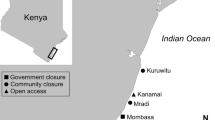Synopsis
Algal growth and damselfish (Eupomacentrus planifrons) territories were studied in two reef habitats at Discovery Bay, Jamaica. Damselfish territories were contiguous in the reef flat (0 to 2.5 m), where the algal composition and biomass varied from territory to territory. In contrast, on the lower reef terrace (22 m), damselfish territories were often spatially segregated. While the algal composition of the territories was more uniform on the reef terrace, the total algal biomass was lower than in the territories on the reef flat. Damselfish are largely herbivorous, and they defend their territories against most intruding fish, including a number of herbivorous species. Areas of the reef terrace outside of damselfish territories were heavily grazed by herbivorous fishes and contained only small quantities of non-crustose algae.
The reef terrace territories were characterized by a multispecific turf of algae (greens, blue-greens, and reds) covering the Acropora cervicornis framework and by the leafy, brown alga, Lobophora variegata. A rapid reduction in the biomass of brown algae and filamentous algae was noted when damselfish were permanently removed from their territories. Only calcified, encrusting algae — plants apparently somewhat undesirable as fish food sources — would be common on the terrace zone of this reef if damselfish territories were absent. Damselfish territoriality may significantly influence the dynamics of some reefs by increasing the biomass of the algal turf thereby increasing; reef productivity. Since blue-green algae, potential nitrogen fixers, occur in these algal turfs, the fish may also be indirectly affecting reef nutrition.
Similar content being viewed by others
References cited
Adey, W., P. Adey, R. Burke & L. Kaufman. 1976. The Holocene reef systems of eastern Martinique, French West Indies. Atoll Res. Bull. 218: 1–40.
Barlow, G. W. 1974. Extraspecific imposition of social grouping among surgeonfishes (Pisces: Acanthuridae). J. Zool., Lond. 174: 333–340.
Connor, J. & W. Adey. 1976. The benthic algal composition, standing crop and productivity of a Caribbean algal ridge. Atoll Res. Bull. 211 (in press).
Doty, M. 1971. The productivity of benthic frondose algae at Waikiki Beach, 1967–68. Hawaii Bot. Sci. Paper 22: 1–119.
Earle, S. A. 1972. The influence of herbivores on the marine plants of Great Lameshur Bay, with an annotated list of plants. In: B. B. Collette & S. A. Earle (eds.), Results of the Tektite Program: Coral Reef Fishes. Nat. Hist. Mus. of L. A. County, Science Bulletin 14: 17–44.
Emery, A. R. 1973. Comparative ecology and functional osteology of fourteen species of damselfish (Pisces: Pomacentridae) at Alligator Reef, Florida Keys. Bull. Mar. Sci. 23: 649–770.
Goreau, T. F. & N. I. Goreau. 1973. The ecology of Jamaican coral reefs. II. Geomorphology, zonation, and sedimentary phases. Bull. Mar. Sci. 23: 399–464.
Mague, T. & O. Holm-Hansen. 1975. Nitrogen fixation on a coral reef. Phycologia 14: 87–92.
Mathieson, A. C., R. A. Fralick, R. Bums & W. Flahive, 1975. Phycological studies during Tektite II at St. John, U.S.V.I. In: B. B. Collette & S. A. Earle (eds.), Results of the Tektite Program: Coral Reef Invertebrates and Plants. Nat. Hist. Mus. of L.A. County, Sci. Bull. 20: 77–103.
Myrberg, A. A., Jr. & R. E. Thresher. 1974. Interspecitic aggression and its relevance to the concept of territoriality in reef fishes. Amer. Zool. 14: 81–96.
Ogden, J., R. Brown & N. Salesky. 1973. Grazing by the echinoid Diadema antillarum Phil: Formation of halos around West Indian patch reefs. Science 182: 715–717.
Randall, J. E. 1961. Overgrazing of algae by herbivorous marine fishes. Ecology 42: 812.
Sale, P. F. 1974. Mechanisms of co-existence in a guild of territorial fishes at Heron Island, pp. 193–206. In: Proc. 2nd International Coral Reef Symp. (Brisbane).
Sammarco, P. W., J. S. Levinton & J. C. Ogden. 1974. Grazing and control of coral reef community structure by Diadema antillarum Phil.: a preliminary study. J. Mar. Res. 32: 47–53.
Stephenson, W. & R. B. Searles. 1960. Experimental studies on the ecology of intertidal environments of Heron Island I. Exclusion of fish from beach rock. Aust. J. Mar. Freshwater Res. 11: 241–267.
Van den Hoek, C., A. Cortel-Breeman & J. Wanders, 1975. Algal zonation in the fringing coral reef of Curaçao, Netherlands Antilles, in relation to the zonation of corals and gorgonians. Aquatic Botany 1: 269–308.
Vine, P. J. 1974. Effects of algal grazing and aggressive behavior of the fishes Pomacentrus lividus and Acanthurus sohol on coral reef ecology. Mar. Biol. 24: 131–136.
Author information
Authors and Affiliations
Rights and permissions
About this article
Cite this article
Brawley, S.H., Adey, W.H. Territorial behavior of threespot damselfish (Eupomacentrus planifrons) increases reef algal biomass and productivity. Environ Biol Fish 2, 45–51 (1977). https://doi.org/10.1007/BF00001415
Received:
Accepted:
Issue Date:
DOI: https://doi.org/10.1007/BF00001415




